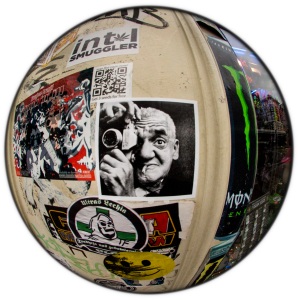Article Dedication
In Memory of
Bob Pace
Dye Transfer Printer Par Excellence
<><><><>
A perennial question that keeps popping up on the photo forums is: ‘Why doesn’t my inkjet prints match my monitor????’
Let me give you the bottom line up front…
The secret of making great prints…is to make lots of work prints.
The Sunlit Slipper 1973
The Sunlit Slipper needed 2 -1/2 hours of Lightroom and thirty-something versions to whip it into shape. I shot it when I was 19 with a beat-up Hassy SWC. Fast forward 40 years and digital tech made it come to life.
But, ‘The secret of making great prints…is to make lots of work prints,’ presupposes you know how to work in post and produce decent prints. If you can’t print well, then making lots of work prints will only end up adding more fuel to the fire, with an ever growing pile of reject prints. Still, an old German saying comes to bear…you grasp by grasping. In other words, practice makes perfect.
The camera fondling, photo forum perfectionist is working overtime so they can transform their monitor and infuse god-like abilities in it with the hopes that each and every print the inkjet printer spits out is a perfect match to the monitor’s image.
Well, I’m here to tell you it does not matter what you want..the only thing that matters is…what is. And what is = prints almost never look the same as the image looks on the monitor. Light is handed differently between the two viewing methods. Reflective light does not = transmitted light. So how can the images look exactly the same?

Sure, having a monitor close to reality is important. Once in a while the monitor and print may be both the same, but most of the time there is a difference. You can see this laptop differs greatly from the desktop screen in what it shows. So start with a good monitor, but just remember monitor calibration only goes so far.
Sometimes we need to produce 2 files for every image – one for printing and one for online viewing. If a gallery is showing a print with a spotlight, it may need a different file for that print as opposed to one that is displayed with diffused light.

Print variations from different printers different papers.
If we use different papers, different websites, then we may need many more variations of the same file to fit various end uses. There are just too many variables against having one perfect do-it-all file.
I’d tell the camera fondlers to lay off the perfection fantasy based on laziness, make lots of work prints and perfect your prints the old fashion way. If you’re on a budget, by all means make 4 x 6 work prints until it is time to get close to the perfected full size prints. Then make larger work prints. Sometimes defects show up on large prints that will be lost in the small prints.
I do recommend you use a print viewing monitor with standardized light source if your serious about exhibition quality printing.
http://www.gtilite.com/gtilite/wp-content/uploads/2014/08/desktop-viewers-feat-image1.jpg
Inkjet printing opened up a new area for the photogs to showcase their work…artists’ books. Sure, the photog could always order a short edition of press run books. But, once the book is hand produced with archival pigment prints it becomes an original work of art in it’s own right.
In the old days we made artists’ book pages by dry mounting silver gelatin prints back to back…very time intensive. I made an edition of 2 books in the 1970’s called Family Portrait by the wet print method…that was enough for me.
There are times when the book maquette or galley proof is under development I use a desktop laser printer for page formatting and page number registration. I don’t even need to use inkjet printers and expensive photo paper for some of the layout and development work.
Having 3 printers going at once is a real time saver for me when it comes to printing books. But when you get 3 printers going full force you had better have the files perfected. Before the book goes into production, I’ve made over a thousand workprints to perfect the hundred or so final prints in the book. Some troublesome files may have 30 or 40 versions before it is perfected.
Still mistakes will happen. On a recent book run I wasted over 30 prints that had to be trashed because an error didn’t show up until after the prints were all done. Doing single sheet feed on multiple printers can make it hard to catch mistakes. Certain papers cannot be fed as a stack and each sheet must be single sheet hand-fed. When you are printing small format book pages and have multiple printers to feed, you end up running back and forth trying to keep up with the feed demands of the printers.
There is no shortcut to perfection. Just put in the grunt work, make lots of work prints. I’ve been printing for nearly 50 years….Type C, Cibachrome, Dye Transfer and all type or silver gelatin prints. If there was shortcut to perfection, believe me, I’d use it.
Vintage 1973 Agfa Brovira silver gelatin print left versus 2013 Inkjet print right.
In the old ‘wet days’ we used color analyzers for dialing in the dichro head of our enlargers. But the analyzer’s purpose was not to give up perfect first prints…its job was to get us in the ballpark. Then as we made more and more work prints we were able to perfect the final print.
If you don’t want to lay off the ‘perfect first time’ fantasy, then keep going in the same direction and pine away with trying to perfect your monitor calibration, soft proofing, etc., and continue asking on the photo forums…‘why don’t my inkjet prints match my monitor????’






